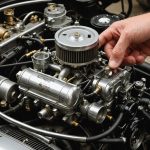Overview of the Belt Drive System
The belt drive system serves as a pivotal component in the Harley-Davidson Softail Slim, famed for its efficiency and smooth operation. It transmits power from the engine to the rear wheel, a task traditionally managed by chains or shafts in other motorcycles. Notably, belt drives differ significantly from their counterparts. They offer the advantage of reduced noise and less maintenance. Unlike chains, they don’t require regular lubrication, making them ideal for riders seeking minimal upkeep.
In the Harley-Davidson Softail Slim, the belt drive system integrates several key components that contribute to its standout performance: the drive belt, front and rear sprockets, and the tensioning system. This setup ensures a smooth, reliable transfer of power, enhancing the overall riding experience. Furthermore, the belts used are robust, often made from materials like strong rubber or polyurethane combined with fibres to resist wear and tear under demanding conditions.
When compared to chain drives, belt drives excel in longevity and cleanliness. Shaft drives, while offering a sealed system, can be heavier and more complex. Thus, for many, the belt drive’s balance of performance, simplicity, and low maintenance makes it a preferred choice for the Harley-Davidson Softail Slim.
Essential Maintenance Tips
Proper upkeep is vital for ensuring your belt drive operates smoothly. Maintenance tips can significantly enhance its performance optimization and longevity.
Also to see : Essential Steps and Tips for Replacing the Steering Damper on Your Honda VTR1000F: A Comprehensive Guide
To start with, establish a consistent frequency and schedule for inspections. Regular checks are crucial, ideally conducted every few months, depending on usage intensity. This proactive approach helps identify wear or potential issues early, preventing costly breakdowns. Ensuring the proper belt tension and alignment is another critical aspect. Misalignment or slack can lead to inefficient power transmission and accelerated wear. Use a tension gauge to verify that tension is within the manufacturer’s specifications, and realign as necessary to avoid unnecessary strain.
In addition to these checks, cleaning plays a pivotal role in belt drive care. Accumulated dust or debris can cause friction and wear. Use a soft, dry cloth to wipe the belt and pulleys regularly. For lubrication, opt for a light, non-sticky lubricant suitable for rubber or synthetic belts, aiding in smooth operation and reducing noise.
Following these simple maintenance tips, including attention to belt condition and consistent cleaning, will ensure your system runs at its peak performance. Save time and money by preventing wear and extending the life of your belt drive system.
Troubleshooting Common Issues
In the world of mechanical systems, troubleshooting belt drive issues is a skill that ensures smooth operation and longevity of the equipment. Issues like noise, slipping, or wear can indicate underlying problems.
Identifying Noise from the Belt Drive
Identifying unusual noises is crucial as they often signal belt drive problems. A high-pitched squeal typically indicates misalignment or improper tension of the belt drive. Low rumbling or knocking sounds can suggest wear in the pulley or too much tension. Listening closely can help diagnose and rectify issues promptly.
Recognizing Slipping or Jumping Belts
Slipping or jumping belts can disrupt operations and damage the drive components. Look for signs like inconsistent performance or fluctuations in speed. A slipping belt leaves a black residue or rubber shavings near the assembly. Misalignment often causes jumping, requiring realignment to restore function.
Understanding Wear Indicators
Understanding wear indicators is vital for predicting belt replacements. Look for cracks, fraying edges, or glazing—a shiny, glazed appearance—on the belt. These signs often mean the belt is nearing the end of its lifespan. Regular checks and replacements prevent unexpected failures and maintain optimal performance.
Proper maintenance and timely intervention keep systems effective, minimizing downtime and maximizing equipment life.
Importance of Regular Inspections
Regular inspections are crucial for ensuring the safety and longevity of any machinery, particularly those with belt drive systems. By performing consistent safety checks, potential issues can be identified early. This proactive approach reduces the likelihood of costly repairs and unexpected breakdowns.
Key Inspection Points: When inspecting a belt drive system, focus on crucial components like belts, pulleys, and tensioners. Look for signs of wear and tear, such as cracks or fraying in belts, which could indicate the need for immediate maintenance. Check pulleys for smooth operation and alignment, ensuring they are free from debris and damage. Tensioners must maintain the correct pressure to prevent slipping or excessive wear.
Preventative Role: Regular inspections play a vital role in preemptively addressing issues that could lead to major repairs. Early detection of problems allows for timely interventions, saving both time and money, and contributes to equipment safety and reliability.
Recommended Intervals and Checklist: Establish a consistent inspection routine, ideally aligning with the manufacturer’s recommendations or usage patterns. A basic checklist might include examining the tension, alignment, and condition of belts, assessing the integrity of pulleys, and ensuring all components are free from wear. Adhering to these guidelines ensures a well-maintained system with reduced risk of failure.
Recommended Tools and Products
Maintaining a belt drive system is crucial for optimal performance and longevity. Choosing the right tools can make this task more efficient. Essential tools for belt drive maintenance include a torque wrench, belt tension gauge, and alignment tool. These ensure precision in adjustments, preventing excessive wear and tear.
For effective cleaning, consider specialized belt drive cleaners. They help remove grime without damaging the material. Lubricants designed specifically for belt drives reduce friction and increase resistance against environmental elements, prolonging the system’s life.
When it comes to products, various specialized solutions are available, particularly for Harley-Davidson motorcycles. They have tailored products that address their unique needs. Comparison among these can highlight aspects like effectiveness, ease of use, and price. Harley-Davidson owners often prefer products recommended by their community for reliability and performance.
A simple checklist for necessary tools would be:
- Torque Wrench: Essential for precise adjustments.
- Belt Tension Gauge: Ensures correct tension.
- Alignment Tool: Guarantees proper alignment.
These tools, combined with the recommended cleaners and lubricants, form a comprehensive strategy for maintaining a belt drive system effectively. Always prioritize investment in quality products to ensure the best care for your motorcycle.
Step-by-Step Guide for Adjusting and Replacing Components
Embarking on a DIY maintenance journey not only saves time but also enhances your understanding of machinery. This section provides detailed instructions for adjusting belt drive, essential for optimum performance.
Adjusting Belt Tension
Ensure the belt’s tension is neither too tight nor too loose for optimal function. To adjust it, first, identify the tensioner and use a wrench to loosen or tighten. Proper tension eliminates unnecessary wear. A good reference is when you can push the belt midway between pulleys with moderate force, resulting in 1/2 inch movement.
Replacing the Drive Belt
Should your belt display irregularities such as fraying or cracking, it’s time to replace it. Begin by switching off the power and removing the guarding cover. Slide the old belt off the pulleys, then fit a new one into place, ensuring it follows the same path. Finish by adjusting the belt tension for the new belt.
Inspecting and Replacing Pulleys
Part of DIY maintenance involves caring for the pulleys. Regularly inspect for wear or misalignment. If replacement is necessary, remove the pulley by loosening its bolt and replace it with a new one, ensuring firmness. Pay attention to how smoothly the belt runs across the pulleys after installation.
Safety Precautions and Expert Recommendations
Ensuring a motorcycle’s longevity is closely tied to adhering to safety precautions during maintenance. When working on your motorcycle, it’s imperative to wear proper safety gear, such as gloves and goggles, to protect against accidental injuries. Before performing any tasks, make sure the bike is on a stable surface to prevent tipping.
Expert advice stresses the importance of thorough, regular checks on key components such as the belt drive. They’re instrumental in the bike’s performance, and periodic inspections can prevent future issues. Ensure that the belt is neither too tight nor too loose; incorrect tension can lead to premature wear.
Documenting each maintenance activity is not just about record-keeping. It provides a comprehensive history of your motorcycle’s care, which can be invaluable when diagnosing issues or when you plan to sell it. This historical log enhances the bike’s value, showcasing your commitment to its upkeep.
Motorcycle experts recommend setting a maintenance schedule tailored to your usage pattern, ensuring your bike remains in peak condition. Following these guidelines and integrating safety precautions ensures your motorcycle not only performs optimally but also maintains its safety standards, benefiting both you and future riders.











